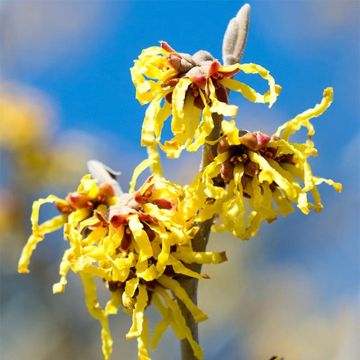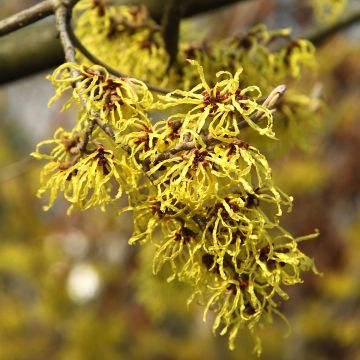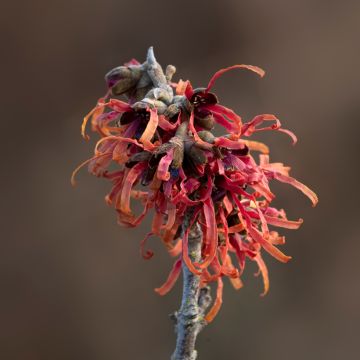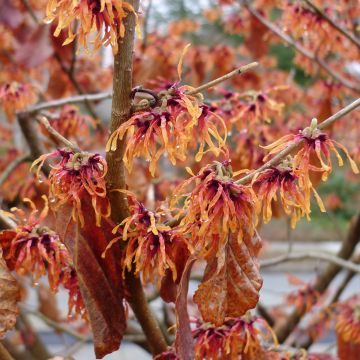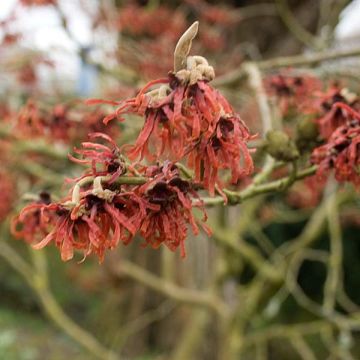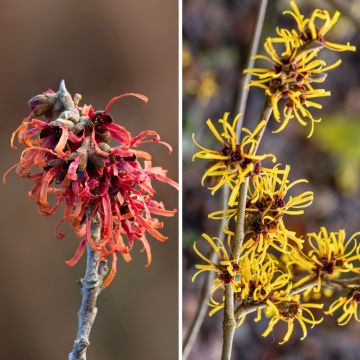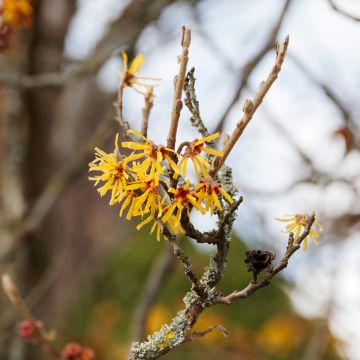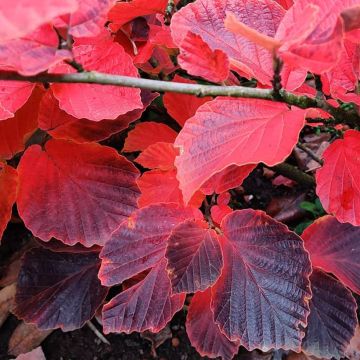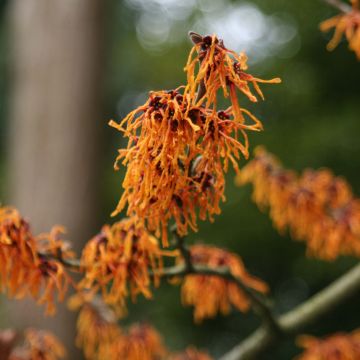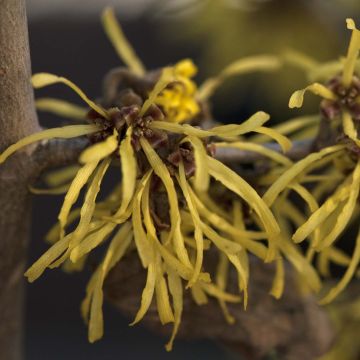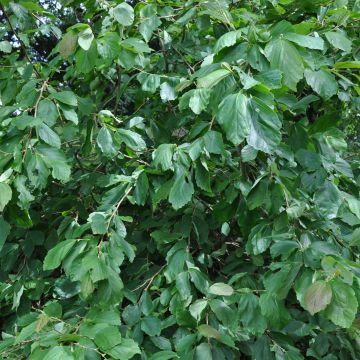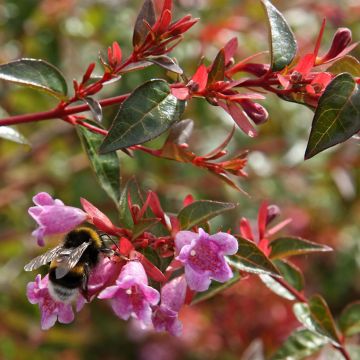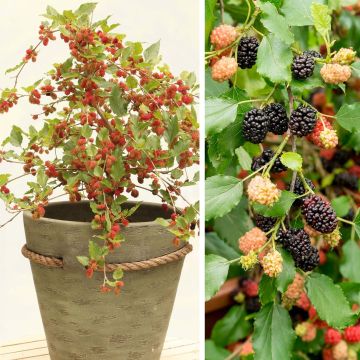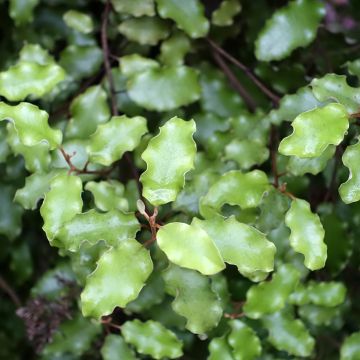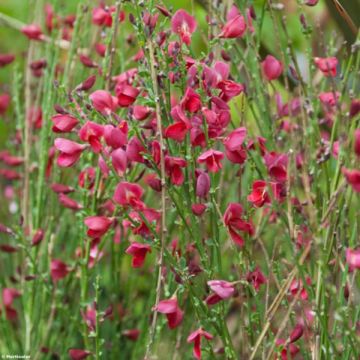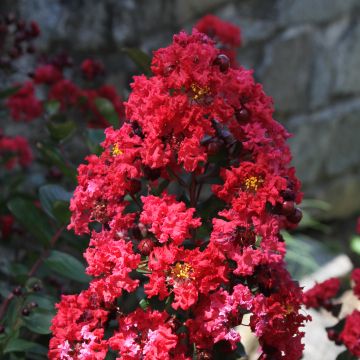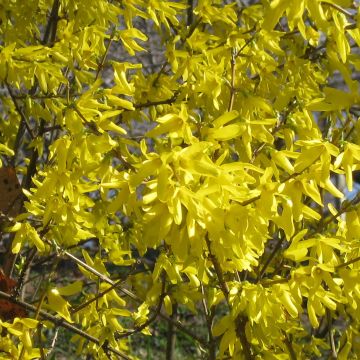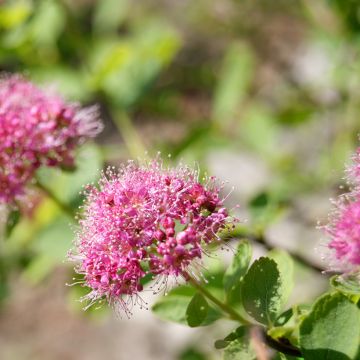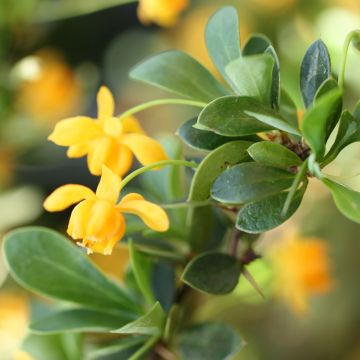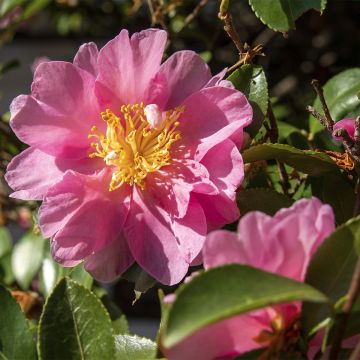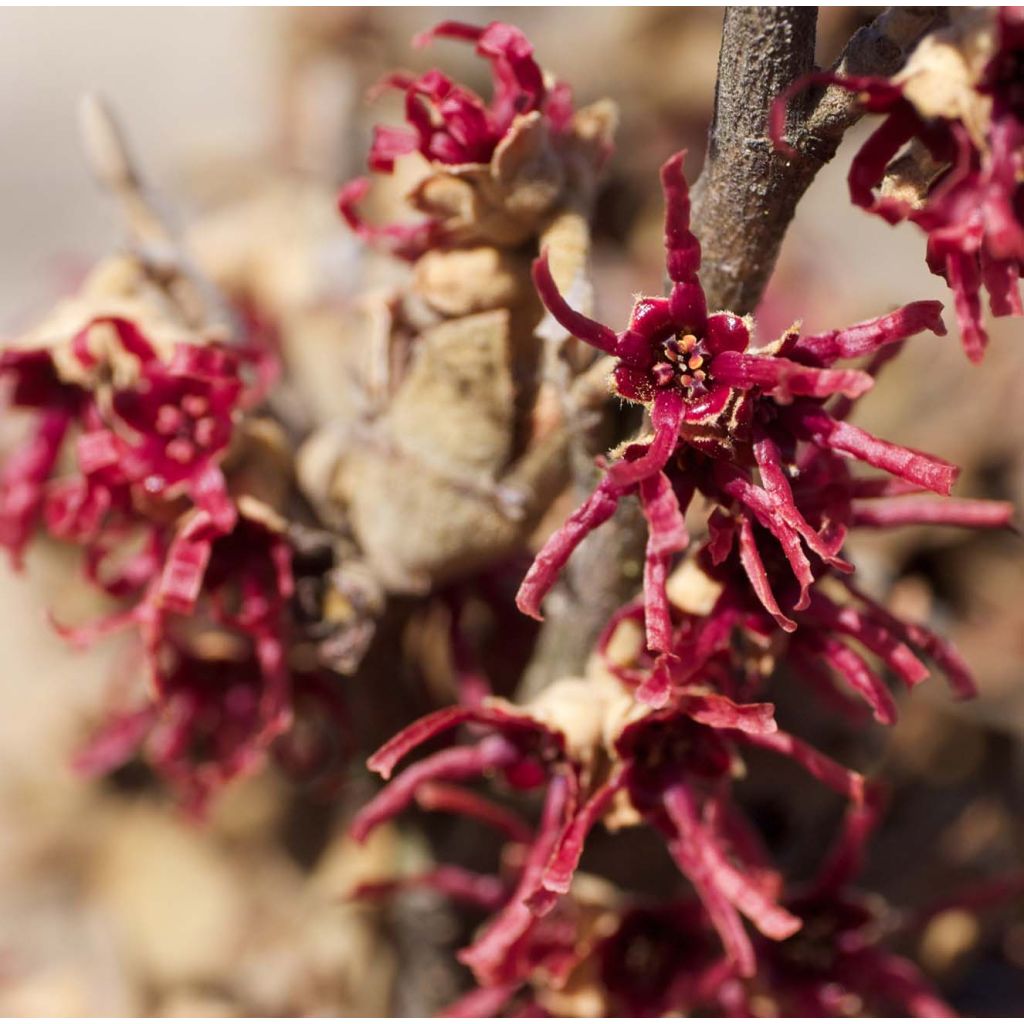

Hamamelis vernalis Amethyst - Witch Hazel
Hamamelis vernalis Amethyst - Witch Hazel
Hamamelis x vernalis Amethyst
Witch Hazel
Why not try an alternative variety in stock?
View all →This plant carries a 24 months recovery warranty
More information
We guarantee the quality of our plants for a full growing cycle, and will replace at our expense any plant that fails to recover under normal climatic and planting conditions.
From €5.90 for pickup delivery and €6.90 for home delivery
Express home delivery from €8.90.
Does this plant fit my garden?
Set up your Plantfit profile →
Description
Hamamelis vernalis 'Amethyst' is a rare cultivated selection of Witch Hazel. This deciduous bush forms a large rounded bush that first captivates with its original and fragrant flowers, a slightly faded old pink to purple tone, so abundant that they almost cover its branches with fluffy sleeves in late winter. It once again captures attention in autumn, when its grey-green hazel foliage turns strongly scarlet, taking on a fantastic appearance. This beautiful variety will bring life to the dormant garden in the cold, planted alongside other winter-flowering shrubs or coloured autumn foliage.
Hamamelis vernalis Amethyst is a horticultural variety introduced in 2003 in the United States, derived from Hamamelis vernalis. The latter is a large stoloniferous shrub native to the centre of North America, specifically the Ozark Plateau, which covers the states of Arkansas, Missouri, and Oklahoma. It is found on rocky slopes along the edges of watercourses. All these plants belong to the hamamelidaceae family, among which we find Loropetalum, Liquidambar, and Persian Ironwood. 'Amethyst' slowly forms a large, vigorous, bushy shrub with a rounded and branched habit, reaching an average of 2.50 m (8 ft 2 in) in all directions at maturity. Its deciduous foliage is composed of ovate leaves, 7 to 13 cm (2.8 to 5.1 in) long and 7 to 13 cm (2.8 to 5.1 in) wide, initially bronze in spring, becoming dark green-grey in summer, then turning coppery orange and flaming red in autumn. In this Amethyst variety, they persist on the branches for a long time before falling. Its fragrant flowers are just as delightful as its colourful foliage. They abound on the bare branches during the months of February and March, composed of elongated petals, a faded pink with lavender highlights, oddly wrinkled, twisted and almost claw-like.
Hamamelis vernalis Amethyst likes humus-rich, low-limestone, moist, light, or even rocky soils. It will thrive in full sun or partial shade. Plant it on the edge of woodland, in front of large trees, or in the back of a flower bed alongside Heuchera, Daphne, Pieris, Sarcococca, and the astonishing Garrya elliptica James Roof, in a milder climate. It will also be magnificent in a flower bed, associated with evergreen shrubs such as an autumn camellia or Chimonanthus praecox. At its base, you can plant winter heathers, Japanese grass, or hellebores.
Report an error about the product description
Hamamelis vernalis Amethyst - Witch Hazel in pictures
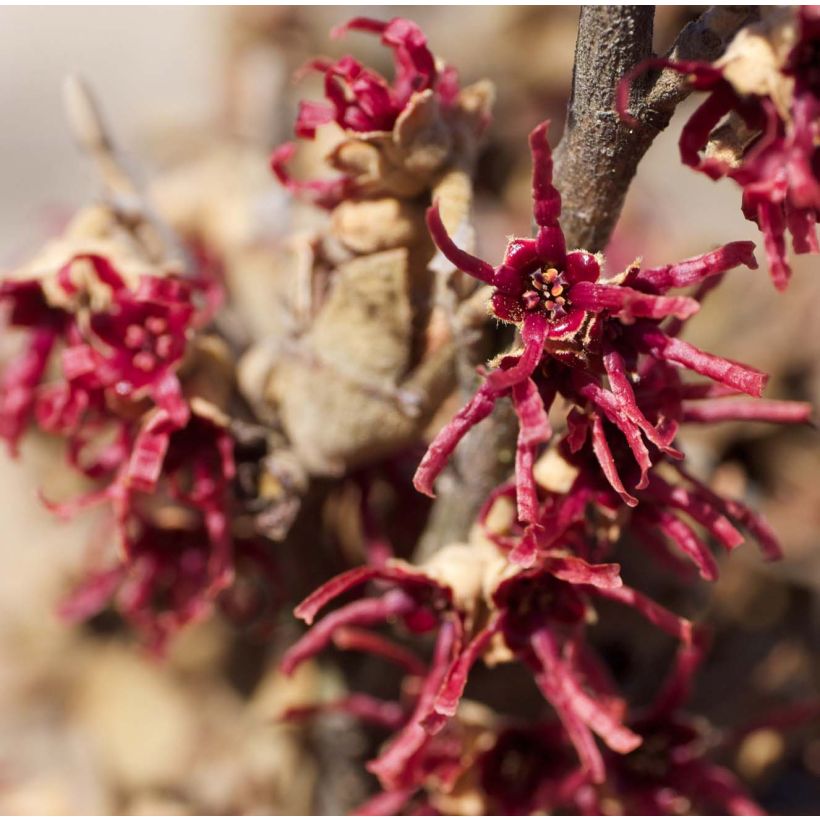

Plant habit
Flowering
Foliage
Botanical data
Hamamelis
x vernalis
Amethyst
Hamamelidaceae
Witch Hazel
Cultivar or hybrid
Other Hamamelis - Witch-hazel
Planting and care
To fully enjoy the beauty of your Amethyst witch hazel, plant it near the house so that it stands out, against a dark background of evergreen foliage. A sunny location will promote better flowering, but not scorching sun. Being sensitive to limestone, it should be grown in ericaceous soil enriched with compost as this variety likes fairly fertile soils, or at the very least in non-limestone soil enriched with leaf compost. Tip: Witch hazels are sensitive to limestone, they indicate this by the summer yellowing of their leaves, and then by flowering less. To facilitate its establishment, incorporate ericaceous soil during planting. The soil in which it is planted should remain moist, even in summer. Mulching around the base of the plant will help maintain moisture. A sufficiently deep and humus-rich soil, even on limestone subsoil, will encourage the growth of the witch hazel.
Planting period
Intended location
Care
-
, onOrder confirmed
Reply from on Promesse de fleurs
Hedge shrubs
Haven't found what you were looking for?
Hardiness is the lowest winter temperature a plant can endure without suffering serious damage or even dying. However, hardiness is affected by location (a sheltered area, such as a patio), protection (winter cover) and soil type (hardiness is improved by well-drained soil).

Photo Sharing Terms & Conditions
In order to encourage gardeners to interact and share their experiences, Promesse de fleurs offers various media enabling content to be uploaded onto its Site - in particular via the ‘Photo sharing’ module.
The User agrees to refrain from:
- Posting any content that is illegal, prejudicial, insulting, racist, inciteful to hatred, revisionist, contrary to public decency, that infringes on privacy or on the privacy rights of third parties, in particular the publicity rights of persons and goods, intellectual property rights, or the right to privacy.
- Submitting content on behalf of a third party;
- Impersonate the identity of a third party and/or publish any personal information about a third party;
In general, the User undertakes to refrain from any unethical behaviour.
All Content (in particular text, comments, files, images, photos, videos, creative works, etc.), which may be subject to property or intellectual property rights, image or other private rights, shall remain the property of the User, subject to the limited rights granted by the terms of the licence granted by Promesse de fleurs as stated below. Users are at liberty to publish or not to publish such Content on the Site, notably via the ‘Photo Sharing’ facility, and accept that this Content shall be made public and freely accessible, notably on the Internet.
Users further acknowledge, undertake to have ,and guarantee that they hold all necessary rights and permissions to publish such material on the Site, in particular with regard to the legislation in force pertaining to any privacy, property, intellectual property, image, or contractual rights, or rights of any other nature. By publishing such Content on the Site, Users acknowledge accepting full liability as publishers of the Content within the meaning of the law, and grant Promesse de fleurs, free of charge, an inclusive, worldwide licence for the said Content for the entire duration of its publication, including all reproduction, representation, up/downloading, displaying, performing, transmission, and storage rights.
Users also grant permission for their name to be linked to the Content and accept that this link may not always be made available.
By engaging in posting material, Users consent to their Content becoming automatically accessible on the Internet, in particular on other sites and/or blogs and/or web pages of the Promesse de fleurs site, including in particular social pages and the Promesse de fleurs catalogue.
Users may secure the removal of entrusted content free of charge by issuing a simple request via our contact form.
The flowering period indicated on our website applies to countries and regions located in USDA zone 8 (France, the United Kingdom, Ireland, the Netherlands, etc.)
It will vary according to where you live:
- In zones 9 to 10 (Italy, Spain, Greece, etc.), flowering will occur about 2 to 4 weeks earlier.
- In zones 6 to 7 (Germany, Poland, Slovenia, and lower mountainous regions), flowering will be delayed by 2 to 3 weeks.
- In zone 5 (Central Europe, Scandinavia), blooming will be delayed by 3 to 5 weeks.
In temperate climates, pruning of spring-flowering shrubs (forsythia, spireas, etc.) should be done just after flowering.
Pruning of summer-flowering shrubs (Indian Lilac, Perovskia, etc.) can be done in winter or spring.
In cold regions as well as with frost-sensitive plants, avoid pruning too early when severe frosts may still occur.
The planting period indicated on our website applies to countries and regions located in USDA zone 8 (France, United Kingdom, Ireland, Netherlands).
It will vary according to where you live:
- In Mediterranean zones (Marseille, Madrid, Milan, etc.), autumn and winter are the best planting periods.
- In continental zones (Strasbourg, Munich, Vienna, etc.), delay planting by 2 to 3 weeks in spring and bring it forward by 2 to 4 weeks in autumn.
- In mountainous regions (the Alps, Pyrenees, Carpathians, etc.), it is best to plant in late spring (May-June) or late summer (August-September).
The harvesting period indicated on our website applies to countries and regions in USDA zone 8 (France, England, Ireland, the Netherlands).
In colder areas (Scandinavia, Poland, Austria...) fruit and vegetable harvests are likely to be delayed by 3-4 weeks.
In warmer areas (Italy, Spain, Greece, etc.), harvesting will probably take place earlier, depending on weather conditions.
The sowing periods indicated on our website apply to countries and regions within USDA Zone 8 (France, UK, Ireland, Netherlands).
In colder areas (Scandinavia, Poland, Austria...), delay any outdoor sowing by 3-4 weeks, or sow under glass.
In warmer climes (Italy, Spain, Greece, etc.), bring outdoor sowing forward by a few weeks.

































